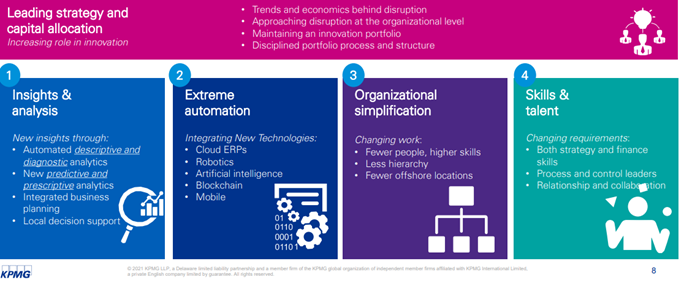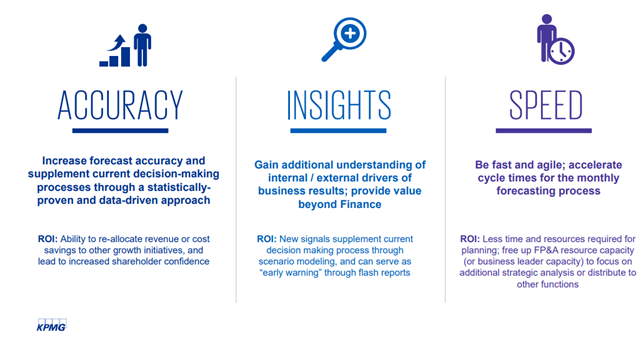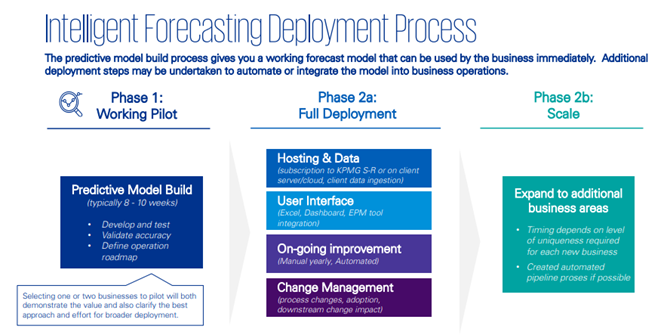The Future of Finance by KPMG was my favorite presentation at our FEI December 2021 CFIT meeting because the big focus was using AI for forecasting (I.e., Intelligent Forecasting). Many months ago, I reached out to FEI members via FEI Connect to find vendors who had software that uses AI to complement a financial forecast of a P&L. FEI Boston member Jay Millstone answered my message and introduced me to Ashok Manthena of Tadaa.ai. Tadaa.ai has a service for finance departments to deploy AI to in various use cases including supporting a financial forecast. This topic is of a personal and professional interest to me, and many FEI CFOs will rely on forecasts using AI if not today, then in the future. A CFO should be aware of the software tools available today and tomorrow. They should be open to how AI and ERP software can support business growth.
As top priorities, 52% of organization will make investments in automation. The future goals were broken down by category as seen below in the KPMG graphic:

Image courtesy of KPMG not to be reproduced or distributed
Predictive analytics to measure and predict companywide business performance. Extreme automation will provide the tools to help you not only track your business in real-time, but also provide insights into a future state with data not readily available today. Robotics and efficiency gains will require fewer workers in data entry and lower skilled work and create opportunities for higher skilled work. There will be a bigger emphasis on business partnering, collaboration and relationships.
Intelligent forecasting combines the data from your ERP system (Internal data) with external data in the form of signals (I.e., data drivers). Data science will use regression, time series and machine learning to augment your traditional forecast with insights from the data-rich algorithms we call AI. Your ERP data is often well-organized and structured for modeling. A finance professional will be more strategic and be supported by more data than ever before.
The signals will be available, maybe free or with a subscription, based on all the data that is being captured today by a variety of sources and organizations. AI can find trends in large datasets and correlate your data, including these signals, in interesting ways. For example, these external signals could be economic data, market data, consumer trends, business spending trends, commodity prices, political events, etc. to be matched and analyzed relative to your historical data to look ahead. What happens to your company’s sales trend when the stock market is booming? Which of your company’s products decline in sales during an economic recession? What is the past trend on your company’s net income, when certain commodity prices drop? These are the questions to ask yourself and if you do not know the answer, AI will be there to support you.
Here is a dashboard created by your FPA team with software tools to incorporate traditional forecasting with signal trends and their impact on your forecast. Instead of crystal ball, it is math and data that can give you insights into the future of your business.

Image courtesy of KPMG not to be reproduced or distributed
Senior financial executives know the importance of ROI on technology projects like Intelligent Forecasting. Improve your forecasting accuracy, gain new insights into your business based on signal correlation, increase the speed to react to your data. Shift your resources to support initiatives that are more profitable based on your strategic analysis. Make faster, data-supported decisions and measure your ROI. Turn your information into good decisions to guide your company forward.

Image courtesy of KPMG not to be reproduced or distributed
Here is a sample Intelligent Forecast deployment plan for your team and other stakeholders. This a project that should get management’s attention and the progress should be reported to your board of directors along with an ROI analysis. A working pilot is the first phase to show the Proof-of-Concept before moving on to the second phase which is full-deployment. As you track your success against a plan, it should be clear for you to scale this technology to other areas of your business, then restart the process. Many disruptive projects fail due to the lack of planning, poor communication and a lack of accountability. Assign people responsibilities in your deployment plan.

Image courtesy of KPMG, not to be reproduced or distributed
“Financial analysts and executives do not want a ‘black box’. There are specific steps we take in order to ensure the new intelligent process is understandable,” shared Peter Irwin, Principal, Data, Analytics & AI, at KPMG. Financial people like audit trails to know the sources of data and how it is generated.
AI is changing our world, and this includes the finance function. Organizations small and large will embrace AI to stay competitive and evolve into the data-driven organizations that will continue to exist into the future. Intelligent Forecasting is available to you today and it will only get more powerful in time.